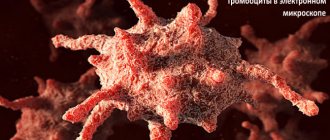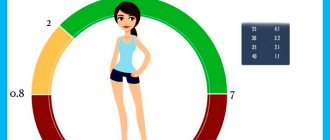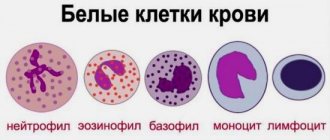Color indicator is a parameter included in the general blood test. It serves as a starting point for diagnosing red lineage diseases with serious consequences. Let's figure out what a color indicator is, to identify what pathology it is needed and how it is determined.
The red color of red blood cells is given by hemoglobin, a combination of protein (globin) with iron ions.
This complex acts as a carrier of dissolved gases: it delivers oxygen into the tissues and removes carbon dioxide from them back into the blood.
The color indicator reflects the level of hemoglobin in the blood cell and the degree of its saturation with iron. The more hemoglobin and carrier metal ions a blood cell can hold, the higher the color of the red blood cell and the more efficient the delivery of oxygen to the tissues.
What else can you get from the indicator?
The digital value of the color blood indicator indirectly allows us to judge the indices.
Calculated by analytical instruments:
- MCH (average hemoglobin content in the blood), the normal value of which is 27-33.3 pg,
- The average concentration of the oxygen carrier in the blood cell (the norm is 30-38%).
Thus, a color parameter of 0.86 corresponds to the lower limit of normal MCH and the average hemoglobin concentration of 30%.
Properties and role of hemoglobin
Erythrocytes, or red blood cells, are capable of forming hemoglobin:
- During respiration, every cell in the body absorbs oxygen, including hemoglobin.
- It is he who is the intermediary who is able to introduce oxygen into tissue cells.
- In this case, red blood cells perform only a transport function.
- In addition, oxygen “takes” carbon dioxide from cells and removes it through the lungs.
The hemoglobin molecule is a complex chromoprotein consisting of four hemes and the globin protein. The heme center contains iron, which ensures the binding of oxygen in the lungs.
When hemoglobin combines with oxygen, it forms oxyhemoglobin, which splits off an O2 molecule and adds carbon dioxide. As a result, carbohemoglobin recedes from tissues that have received their oxygen supply.
Reference! Oxyhemoglobin and carbohemoglobin are physiological compounds of hemoglobin.
Another function of hemoglobin is to maintain acid-base balance. It, along with three other buffer stations, maintains a constant pH at 7.36-7.4.
Hemoglobin regulates oncotic pressure, maintaining normal blood viscosity and preventing water from leaving tissues.
Hemoglobin synthesis occurs in the bone marrow when its red cells are just beginning to form.
The video explains what hemoglobin is:
How to calculate?
The color index can be calculated independently. To do this, you need to know the level of hemoglobin and the number of red blood cells, which is designated as RBC.
The formula used to calculate the parameter:
Hemoglobin level*3/the first 3 digits of the red blood cell level, inserted into the formula without a comma.
If the analyzes indicate two numbers separated by a comma, you need to remove the comma and add 0. The number 3 in the formula is unchanged. Calculation example for a hemoglobin level of 160 g/l and RBC=4.5 g/l:
160*3/450=1.06. The resulting figure corresponds to the color indicator (not measured in conventional units).
Calculation in two steps
The color index is calculated using the formula: CP = hemoglobin x 3: number of red blood cells.
For example, with a red blood cell count of 4.2 x 1012/l and a hemoglobin level of 128 g/l, the color index will be 0.9 (128 x 3 and divided by 420), which corresponds to the norm (normochromia). Meanwhile, it should be noted that normochromia does not always mean normal. A proportionally reduced number of red blood cells and hemoglobin will also have a similar designation - normochromia, but in this case we will talk about normochromic anemia. In addition, there are other situations:
- There may be a lot of red blood cells or their number is at the upper limit of normal, for example, 4.7 x 1012/l with hemoglobin 120 g/l. When calculating the color index (120 x 3: 470 = 0.76), it is discovered that it does not fit into normal values, that is, red blood cells circulate “empty”, there are many of them, but they do not contain sufficient hemoglobin (hypochromia). This phenomenon indicates the development of anemia, the type and cause of which should be clarified by further hematological studies.
- The content of red blood cells in the blood is normal (for example, for women 4.0 x 1012/l) or near the lower limit of normal, and hemoglobin is high (160 g/l), and after calculating the CP it turns out that it exceeds 1.0 ( 160 x 3: 400 = 1.2). This means that the red blood cells are excessively saturated with hemoglobin and in such a case they speak of hyperchromia - the blood of such people is thick and “heavy”.
Norms
The color indicator in a healthy person is within the following values:
| Gender, age | Norm |
| Men | 0,86-1,05 |
| Women who are not pregnant | 0,86-1,05 |
| Pregnant | 0,85-1,0 |
| Newborn babies | 0,9-1,3 |
| 1-3 years | 0,85-0,96 |
| 3-12 years | 0,85-1,05 |
| Over 12 | 0,86-1,05 |
The condition in which the red blood cell contains the optimal amount of hemoglobin and iron and has a normal red color is called normochromia (normo + chromos - color). The deviation of the color parameter can be towards hypo- (decrease, decrease) or hyperchromia (increase).
The result is evaluated as follows:
- Hypochromia (CP 0.85 or less),
- Normochromia (0.86-1.05),
- Hyperchromia (over 1.06).
The color index norm is the same for men and women of all ages. Pregnancy is the only condition that is not a disease in which the color index is reduced in an adult. The low rate is explained by physiological anemia characteristic of the 3rd trimester.
Interesting. A higher norm is typical for a child of the first year of life. It is explained by the presence in infants of fetal red blood cells with a high concentration of hemoglobin. By adolescence, the rate becomes the same as in adults.
An altered (above or below normal) color indicator goes hand in hand with decreased red blood cells and indicates anemia.
Calculation
The purpose of calculating the color blood index is to determine whether the level of hemoglobin in one red blood cell cell corresponds to the norm, i.e. how good it is, as a ratio of indicators.
The resulting index has been used for a long time and successfully; to determine the indicator, two initial values are required - how many red blood cells and hemoglobin are in the analyzed sample.
For this calculation, the formula is used:
The normal color index for an adult can be indicated by a level from 0.85 to 1.00.
If the calculated indicator of the analyzed sample is higher than normal, they speak of hyperchromia, if the color indicator of the blood is reduced - hypochromia.
When analyzed on automatic analyzers, the color indicator of blood allows one to calculate the ratio of the numerical concentration of hemoglobin to the number of red blood cells per unit volume of the liquid being tested. This looks like the number obtained by dividing the hemoglobin number (g/l) by the number of red blood cells. The name of this analysis is MSN and its result is conventionally taken as a color indicator. Normal MCH values in an adult male are 27–34 pg, similar in women, in newborns up to 14 days — 30–37 pg, up to one month — 29–36 pg, up to two months — 27–34 pg, up to 36 months — 22 –30 pg, up to 13 years old 25–31 pg, up to 16 years old 26–32 pg, up to 17 years old 26–34 pg. What is a picogram in analysis? This is a unit of weight representing 1 trillionth of a whole.
| Newborns up to 14 days | 30 - 37 pg |
| Children under 1 month | 29 - 36 pg |
| Children under 2 months | 27 - 34 pg |
| Children under 3 years old | 22 - 30 pg |
| Children under 13 years old | 25 - 31 pg |
| Children under 16 years old | 26 - 32 pg |
| Children under 17 years old | 26 - 34 pg |
| Women | 27 - 34 pg |
| Men | 27 - 34 pg |
Relationship between color indicator and red blood cell size
Cells overflowing with hemoglobin have an increased size and are called megalocytes. Their diameter exceeds 8 microns.
The higher the color index, the larger the size of the blood cell. The diameter of red blood cells with a normal color value is in the range of 7-8 microns.
If during maturation the red blood cell is not saturated with a sufficient amount of red pigment, its diameter remains reduced - 6.9 microns or less.
Such a cell is called a “microcyte,” and anemia, for which a microcyte is characteristic, is called microcytic.
How the examination is carried out: blood test
The indication for laboratory diagnostics of red blood cells is to identify anemia. In order to correctly identify any abnormalities in the tests, it is important for the patient to adhere to the following rules before collecting biological fluid:
- Donate blood on an empty stomach in the morning;
- Do not eat food 8 hours before coming to the clinic;
- Do not drink alcohol-containing drinks and avoid fatty foods on the eve of the general analysis.
If the diagnosis is carried out correctly, reliable data will be obtained without false indicators. Based on them, the doctor will be able to understand whether it is necessary to refer the patient for additional examination or whether his health condition is normal.
A low color index indicates the presence of hypochromic anemia. As a rule, it is caused by iron deficiency in the body and is easily treated by adjusting the diet or prescribing medications. But there are also more serious pathological changes that reduce CPC.
Does it happen that hypochromia is detected with normal hemoglobin? Usually in such situations they do not talk about anemia, since all other indicators are normal. Most likely, the test result is not reliable and it is better to take another blood test to determine the exact data.
What does a lower level mean?
About disruption of hemoglobin synthesis.
A low value indicates hypochromic microcytic anemia (with low hemoglobin and red blood cell count).
Blood cell anemia
This type of anemia includes:
- Iron deficiency,
- Chronic posthemorrhagic,
- Sideroachrestic,
- Hypoplastic.
All of them are a consequence of low hemoglobin; they are united by a violation of the incorporation of iron ions into the erythrocyte.
Iron-deficiency anemia
Iron deficiency is the most common cause of hypochromic anemia.
The disease occurs due to:
- Insufficient consumption of animal products,
- Inflammatory process of the small intestine, leading to decreased absorption of microelements through the mucous membrane,
- Pregnancy, lactation, intensive growth in children.
Anemia in pregnant women not only worsens the woman’s condition, but also negatively affects the hematopoiesis of the fetus. It responds well to treatment with iron supplements, which are safe for the unborn child.
To make a diagnosis, you need to know the level of iron in the plasma and the total iron-binding capacity of the serum (TIBC).
Chronic posthemorrhagic anemia
The reason is constant bleeding, in which the loss of iron exceeds its intake from food.
Anemia develops with the following diseases:
- Erosive gastritis,
- Peptic ulcer disease,
- Hemorrhoids,
- Heavy, prolonged menstruation, intermenstrual bleeding due to hormonal imbalances.
Sideroachrestic
The disease is caused by a hereditary disorder of hemoglobin synthesis in the bone marrow. The body does not lack iron, it is simply unable to incorporate it into hemoglobin.
Hypoplastic
It can be determined by bone marrow puncture. In the analysis of punctate, there are damaged stem cells that are unable to absorb a sufficient amount of hemoglobin.
Reasons for deviation from the norm
Deviation from the norm may have the following reasons:
- oncological processes or benign formations;
- pernicious anemia;
- Iron-deficiency anemia;
- lack of folic acid and other microelements, vitamins and minerals in the body;
- acute or chronic blood loss;
- poisoning with toxic substances;
- anemia, which is common during pregnancy;
- diseases of the cardiovascular system;
- effect of penetrating radiation.
Only a doctor can establish the exact reasons that led to a deviation from the norm by carrying out all the necessary diagnostic procedures.
It should be noted that the analysis when determining the diagnosis is never considered as a separate unit. In combination with other laboratory and instrumental diagnostic measures, the test makes it possible to determine the type and severity of the pathological process.
As for the clinical picture, the nature of the disease will completely depend on the underlying factor. If you feel unwell, you should consult a doctor, and not self-diagnose and start treatment based on a pseudodiagnosis. A timely visit to a doctor significantly increases the chances of a full recovery.
What does an increased value mean?
Lack of vitamin B12 or folic acid. As a result, red blood cells with large sizes and a high concentration of hemoglobin are formed. Blood cells with such parameters die prematurely.
Hyperchromic anemia (with a high color index) is caused by the following reasons:
- Gastritis, enteritis with atrophy of the mucous membrane, in which the protein that ensures the absorption of the vitamin ceases to be produced,
- Secretory insufficiency of the pancreas in pancreatitis,
- Severe liver dysfunction,
- Competitive consumption of vitamins by intestinal helminths,
- Long-term treatment with folic acid antagonist drugs: Methotrexate, Aminopterin, Neomycin, PAS,
- Disease of the thyroid gland with hormonal imbalance,
- A diet low in vitamin B12 and folic acid.
Important! Anemia does not always occur with a change in color parameter. In some conditions, normochromia (reduced number of red blood cells, but normal hemoglobin levels) is observed. It is characteristic of kidney disease and acute blood loss.
What to do if the blood color indicator decreases
Treatment for low blood color index is prescribed taking into account the cause. First, the underlying disease is treated. Additionally, it is recommended to adhere to proper nutrition and abandon a vegetarian diet. Avoid smoking and drinking alcohol.
The blood color index is low in a small child - his nutrition needs to be adjusted. During periods of intensive tissue growth, tissues consume a lot of iron. The diet should include meat dishes, fresh vegetables and fruits.
If the blood color index is low in an adult, it is also recommended to start with regulating nutrition. If signs of anemia persist, iron supplements are prescribed.
Nutrition
A diet aimed at restoring CP should contain foods rich in iron and vitamins. In mild cases of deficiency anemia, proper nutrition allows you to restore hemoglobin levels and CP without the use of medications.
Iron-rich foods:
- meat by-products;
- red meat;
- green apples;
- buckwheat grain;
- grenades.
The absorption of iron improves with the simultaneous use of ascorbic acid. You should eat fresh vegetables and fruits, berries every day. Microelements and vitamins are destroyed during heat treatment. Vegetables, fruits and berries are best consumed raw.
Medications
If the color index is reduced to 0.6 or less, the nutrition will not be effective enough. Prescribed iron supplements:
- Sorbifer;
- Ferrum Lek;
- Maltofer;
- Ferro foil.
Medicines are available in the form of syrups for small children, tablets for older children and adults. There are combination preparations with additional content of ascorbic and folic acid. To improve absorption, ascorbic acid is prescribed additionally - if it is not in the drug.
The dosage and course of treatment are determined by the doctor, taking into account the tests. The minimum course of treatment is a month after restoration of hemoglobin and CP levels - a total of 1.5-2 months.
Prevention
Increased hemoglobin
High hemoglobin is a sign:
- Hypoxia (lack of oxygen),
- Dehydration,
- Chronic infection.
It indicates the body is working under stress and is a harbinger of depletion of health resources.
In addition to a general blood test, a biochemical test, which is also prescribed by a therapist, is informative.
He will indicate what is needed to prevent high hemoglobin:
- Rationalization of physical activity,
- Rejection of bad habits,
- Sanitation of foci of chronic infection,
- Healthy diet.
Products that lower hemoglobin:
- Plant-based meals: salads, raw vegetables,
- Seafood,
- Dietary meat,
- Legumes.
Reduced CPU
When the blood color index is low in an adult, its value is below 0.8. This means there is a low amount of red blood cells in the peripheral blood sample. This phenomenon is called hypochromic anemia (or microcytic deficiency).
Hypochromic anemia is caused by congenital hemoglobin pathologies. The most common cause of microcytic deficiency is a lack of iron in the body.
Reasons for reduced CPU:
- Heavy menstruation in women.
- Presence of bleeding in the stomach or intestines.
- Pregnancy period.
If anemia is at a mild stage in men and women, the symptoms are minor:
- Feeling tired more often.
- There is no desire or strength to do the work.
If the disease becomes complex, the characteristic signs become more severe:
- Breathing becomes difficult.
- The heartbeat quickens.
- The pulse accelerates.
- The skin takes on a white tint.
- The mucous membranes of the eyes become inflamed.
How to help a child?
If a low CP is detected in the baby’s biochemical blood sample, you need to go to the pediatrician. The doctor, taking into account other indicators and the general clinical picture, will refer the little patient for additional examination to find out the reason for the low indicators.
Treatment of a child
Since in most cases a decrease in CP is observed due to anemia, a general analysis will show a reduced number of red blood cells and a reduced hemoglobin concentration. The child will be prescribed a treatment method with iron-containing medications and a special diet that involves eating foods rich in iron. The therapy lasts at least a month.
If a reduced CP indicates kidney disease, the child will be prescribed a urine test and ultrasound.
Color index in children
The color index of a child’s blood may be reduced not only due to iron deficiency, but also due to insufficient kidney function. Therefore, it is necessary to take control blood tests every time. If deviations in the decoding of the results are detected, you need to quickly respond and begin treatment.
Blood table
A decrease in the CP coefficient is commonly called hypochromia. It often appears when the production of red blood particles and their replenishment with hemoglobin protein is impaired due to a lack of iron. In this situation, normal red blood cells may lack hemoglobin, or the blood cells themselves may decrease in size.
If a low parameter is detected in a newborn, this is due to the presence of anemia in the mother during pregnancy or improper nutrition of the mother during breastfeeding. In young and older children, anemia occurs due to a lack of important microelements in the diet if the child eats irregularly or does not receive meat and fish foods.
Another factor influencing the decrease in hemoglobin levels may be physiology: too rapid growth of the child or lack of physical activity, diseases of the digestive system, which makes nutritional components poorly absorbed.
There are other reasons for CPU decline:
- Insufficiency of kidney function.
- Bone marrow diseases.
- Liver diseases.
- Swine flu.
- Tumor neoplasms.
- Hemoglobinopathy.
- Hemolytic streptococcus.
- Intoxication with heavy metals.
Characteristics of symptoms:
- The face turns pale.
- The child becomes lethargic and inactive.
- Refuses to eat or wants to eat something inedible.
- The head is spinning, there is noise in the ears.
- Cold feet and hands.
- Hair and nails are in poor condition.
- Frequent heartbeat.
- Dyspnea.
- Bad dream.
- Frequent colds and infections.
Prevention and prognosis
In order to prevent fluctuations in the central nervous system, parents need to strictly monitor the implementation of several simple general preventive recommendations, among which it is worth highlighting:
- healthy and nutritious nutrition;
- preventing the penetration of chemical or toxic substances into the child’s body;
- refusal to take medications for no apparent reason;
- frequent exposure to fresh air;
- avoiding physical and emotional exhaustion;
- Regular visits to the pediatrician and, if necessary, to other pediatric specialists.
In itself, fluctuations in the CPC do not in any way threaten the lives of children. However, complete refusal of medical care by parents increases the likelihood of the child developing complications and consequences of the underlying disease, which can be fraught with an unfavorable prognosis.











